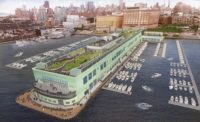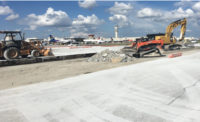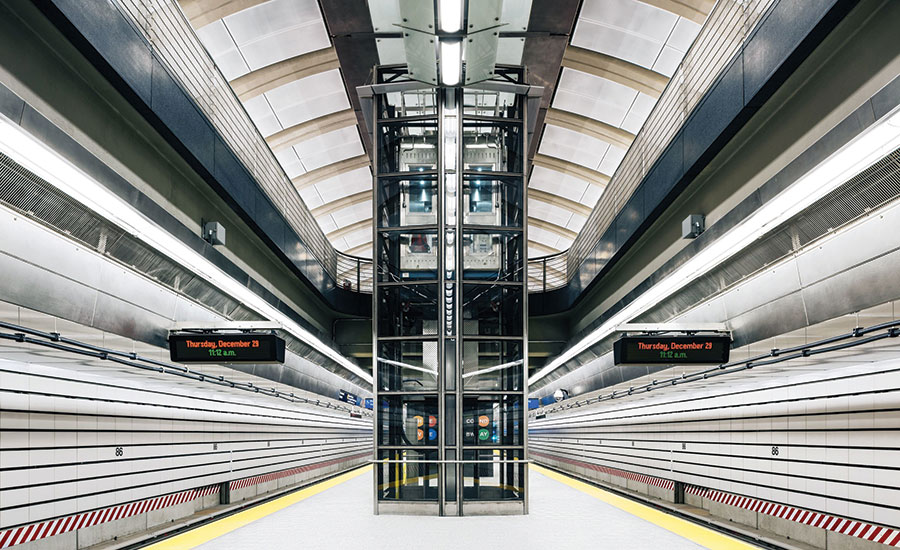Rail Infrastructure
A New Era of Transit
Buoyed by socioeconomic trends and political will, transit projects are hatching across the U.S.

Manhattan’s new Second Avenue subway includes updated features, facilities and retail.
PHOTO COURTESY OF ARUP

Manhattan’s new Second Avenue subway includes updated features, facilities and retail.
PHOTO COURTESY OF ARUP

Legacy systems, such as the Bay Area’s BART, must juggle upgrades and maintenance with expansions.
PHOTO COURTESY OF BART

Another trend is to transform old rail stations into destinations, not just terminals, such as in Boston’s upgrade.
PHOTO COURTESY OF CITY OF SPRINGFIELD, MA, OFFICE OF PLANNING AND ECONOMIC DEVELOPMENT

The Washington, D.C., Metro system is undergoing a series of extended shutdowns for extensive track repair.
PHOTO COURTESY OF DC METRO

In Washington, D.C., the second-phase expansion to Dulles airport is going full steam, but older parts of its system require extensive emergency repairs.
PHOTO COURTESY OF MWAA

The Crenshaw subway is one of dozens of transit lines being built in LA Metro’s multibillion-dollar program, which received a funding boost last November.
PHOTO COURTESY OF LA METRO

Florida’s privately owned Brightline system this year will debut its first line, between Miami and West Palm Beach.
PHOTO COURTESY OF ALL ABOARD FLORIDA








Election Day 2016 marked a new era of hope for the U.S. mass-transportation construction sector—and it went beyond presidential promises. On that day, voters around the country approved $170 billion worth of ballot measures, largely state or sales-tax increases, specifically for transit.
“It was historic,” says Art Guzzetti, vice president of policy for the American Public Transportation Association. While the percentage of transportation-related ballot success was consistent at 70%, “what was different last year is the number of really big measures and the amount of money marked specifically for transit.”
He cited cities—Atlanta, Indianapolis, Spokane, Wash., and Raleigh, N.C., among them—that, previously, had not succeeded in winning a majority of voter support for such ballot measures. In particular, two measures worth $2.5 billion and $300 million will fund Atlanta-area transit projects through sales-tax increases.
"Communities and cities across the country are wanting and asking for more investment in mass transit," says Paul Skoutelas, national director of transit and rail at WSP Parsons Brinckerhoff. "It's about not only preserving what you got but having new investments to make. Since 2000, we’ve seen ballot measures in urban settings across the country passing at a rate greater than 70%.Our cities and urban areas are maturing to the point that they recognize the value."
Another big milestone came on Jan. 1, with the opening of the $4.5-billion first phase of New York City’s Second Avenue subway, which packed in the crowds. While transit growth is to be expected in Manhattan, cities across the country also are anticipating increasing demand for light rail, subways, intercity rail, streetcars and bus rapid transit.
Industry insiders expect this demand for the long term. Steady population growth, urbanization, the knowledge economy and the millennials’ desire for multiple transport options are here to stay, they say.
“This trend won’t be stopping,” says Rich Cavallaro, CEO of Skanska USA. “Cities need to be connected—and that starts with the ability to move freely. We’re also seeing some long-haul stuff between states.”
Fortunately, he adds, “Both sides of the aisle are pro-infrastructure, talking about a trillion dollars for it.
Let’s hope the [federal] money shows up.”
Federal funding certainly would help local authorities to plan for the transit their constituents have indicated they want and need. For example, Houston is focused on wrapping up its current light-rail extensions, but “it’s more of a wait-and-see” regarding federal contributions to future ones, says Michael Johnson, president for infrastructure at Parsons Transportation Group. One option in lieu of getting more federal funding would be to consider bus rapid transit, he adds.
Peter Rogoff, chief executive officer of Washington state’s Sound Transit and Federal Transit Administrator for five years, says national transit faces two key concerns. One need is maintaining funding for maintenance and doing the work without service interruptions.
The second issue involves staffing. Along with other growing agencies in the western states, Sound Transit needs “to make sure there is adequate capacity in construction vendors and trained professionals going forward.” The agency has $80 billion and 116 miles’ worth of expansion slated over the next 25 years.
The first point is huge for legacy systems. In the past two years, the Washington (D.C.) Metropolitan Area Transportation Authority, or WMATA, has undergone a series of power-system fires, derailments and other service disruptions. Paul J. Wiedefeld, WMATA’s new CEO and general manager, established an accelerated maintenance program called SafeTrack, which got underway in mid-2016. WMATA hopes to cram three years’ worth of repairs into about 12 months by augmenting an expanded maintenance program during weekends and non-operational hours, with 16 “surges,” or extended shutdowns of specific sections for repair. At the same time, a $2.8-billion, 11-mile extension to Dulles airport is well underway.
In the Bay Area, an approved ballot measure will raise $3.1 billion, mostly for “state of good repair” projects, says Robert Mitroff, chief planning and development officer with the Bay Area Rapid Transit Authority (BART). At the same time, BART is still expanding. For example, a 10-mile extension through Contra Costa County is winding down as part of a $1.3-billion program that also expanded Interstate 4. “One of the things we’ve been observing here is that there doesn’t seem to be just one way to transport people anymore,” says Ivan Ramirez, construction manager with the county transportation authority. “At the end of the day, we worked together to build a multimodal corridor.”
In New York City, on the Second Avenue subway, three of the four stations were new, but they still had to tie into the existing, 100-plus-year-old network, notes Craig Covil, infrastructure executive with Arup, which, with AECOM, provided engineering and architectural services. “It is typically easier to start design with a blank piece of paper,” he said, noting the difficulties of updating existing stations.
But in cities across the country, from Boston to Chicago to Washington, D.C., transit builders are planning to do just that. Their goal is to transform arrivals-and-departures facilities into a destination unto itself, as well as a truly multimodal hub.
When, in 2001, Denver’s Regional Transportation District (RTD) purchased the downtown Union Station, paying $50 million for 19 acres, “everyone thought we were crazy,” recalls Phillip Washington, a former RTD manager. Literally, tumbleweeds were rolling through the desolate area. At that point, a ballot measure to fund an ambitious $5.3-billion FasTracks transit construction program, building 122 miles of new lines and dozens of stations across the Denver metro area, was still three years away.
State of the Union Stations
Fourteen years later, most of the rail system is complete, thanks in part to the $2.2-billion Eagle P3 project, the country’s first-of-its-kind and one Maryland is emulating with the $5.6-billion Purple Line. The downtown Denver station, re-opened in 2014, is buzzing with retail activity and related real estate revenue is about $1 billion, Washington says. He now is CEO of Los Angeles Metro, which hopes to emulate Denver and revamp its own downtown Union Station. LA Metro already is in the midst of billions of dollars of transit work; in November, voters agreed to raise sales taxes to pump in $120 billion more over the next 40 years.
The focus is on multimodal development, including accommodating future high-speed rail, says Thomas Waldron, transit director with HDR, a Metro consultant on conceptual design and analysis. “The goal is to make it a more functional flow-through facility, improve commercial opportunities and develop under-used parcels.”
There are plenty of P3 opportunities for station redevelopment. In western Massachussetts, for example, Springfield’s $94-million, 200,000-sq-ft Union Station is nearing completion. The complex includes 26 bus berths for public and private carriers, an Amtrak station and a CSX freight line. “We’re putting in furniture and have announced tenant leases for three of four retail spaces [of the 64,000 sq ft of total leasable space] and are negotiating commercial and transportation leases,” says Kevin Kennedy, executive director of the Springfield Redevelopment Authority. “We’re going back to rail. It’s back to the future in Springfield.” Kennedy says an initial 4 million annual riders are expected to use the new station.
Modal Mix
These hubs are accommodating not only subways, light rail and buses but also bikes, streetcars and intercity rail—high-speed rail in the case of California and higher-speed rail in the case of Florida, where the privately owned All Aboard Florida this year will open a Miami-to-West Palm Beach line, the first segment of its $2.5-billion Brightline system.
For advocates such as Andy Kunz, president and CEO of the US High Speed Rail Association, the developments represent a sea change. “Public dialogue has changed. In 2009, the message was that rail was a fail,” he says. “We’ve gone in eight years from an anti-rail attitude to a lot of positive discussion.”
That goes for streetcar work, as well. In Charlotte, N.C., Johnson Bros. Corp. has begun work on a 2.5-mile, $150-million extension of the original 1.5-mile line. Balfour Beatty Construction and The Lane Construction Corp., with construction manager HNTB, are completing work on the 9.3-mile, $1.2-billion LYNX Blue Line light-rail extension project, which began in 2014. The city of Charlotte also is working on the future Charlotte Gateway Station Project, a downtown multimodal station that includes Amtrak and bus service as well as adjacency to light-rail and streetcar service.
In Phoenix, Valley Metro is launching its $186-million Tempe Streetcar line. The agency recently approved a construction manager-at-risk contract with Stacy and Witbeck Inc., which will partner with the city, project designer Stantec and contractor Sundt Construction. Construction of the three-mile streetcar route will begin later this year, with an anticipated opening in 2020.
Further, Dallas Area Rapid Transit is planning a $2.5-billion program that includes both new light-rail and a streetcar connector project, linking to the historic McKinney Avenue Trolley.
Of course, the big question is how transportation network providers (TNPs)—such as Uber and, eventually, automated vehicles—will affect the current modal mix. “They are frenemies,” says BART’s Mitroff. Although TNPs pose competition, “they also represent a huge potential solution for the ‘last mile’ ”—the distance between a commuter station and home.
Adding that there are discussions with TNPs about providing commuter trips to rail stations, Parsons’ Johnson notes that transit technologies and modes will keep evolving. He says, “As an industry, we continue to be progressive. We have to learn how to work with people who bring ‘moon shots’ to the table.”















